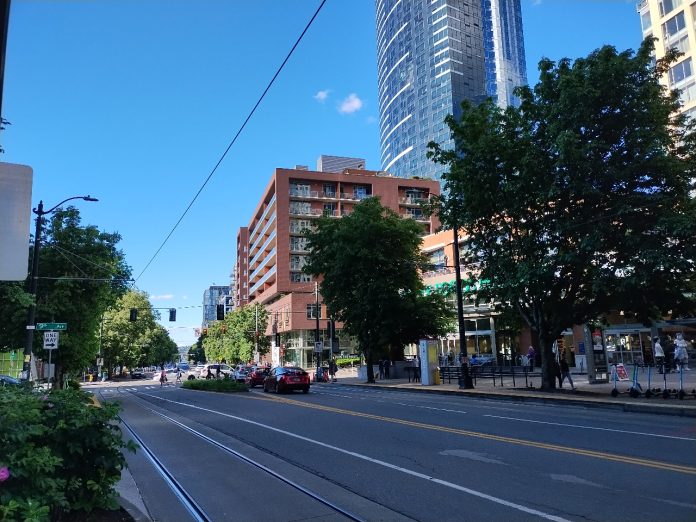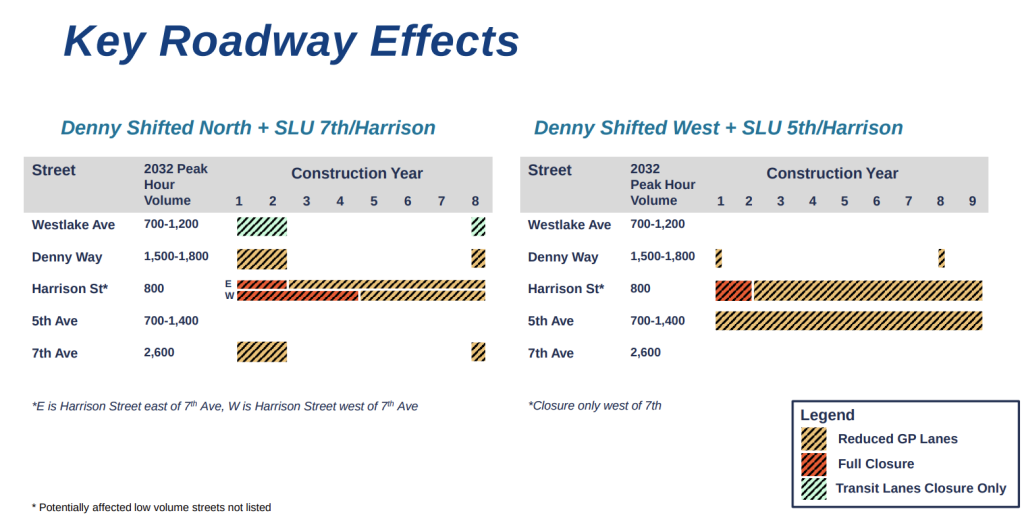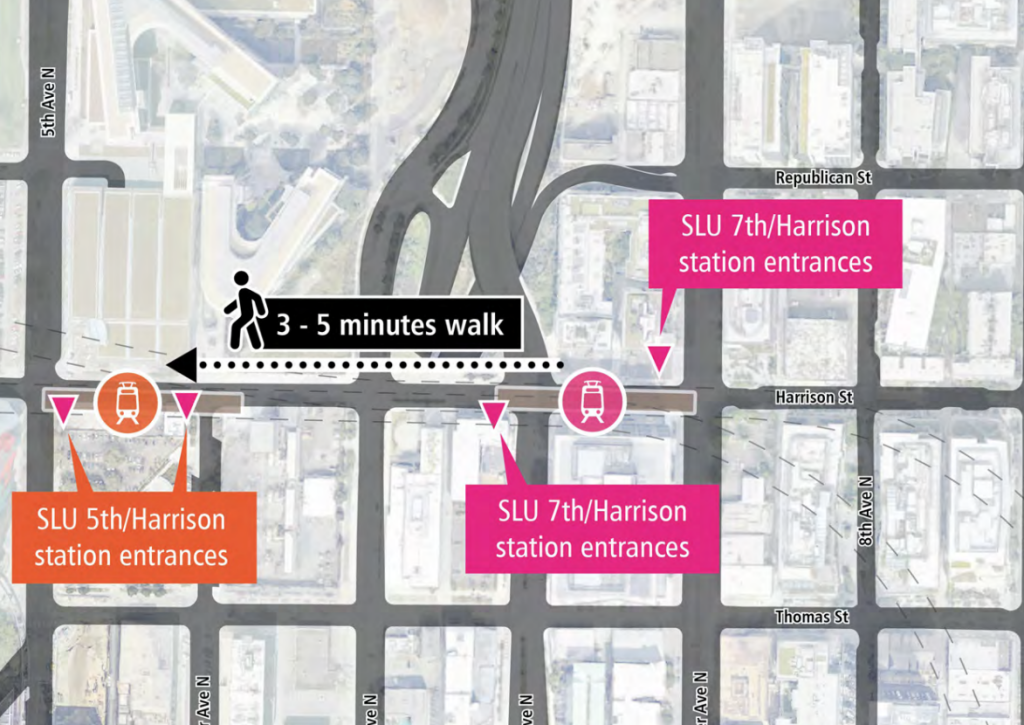
Sound Transit staff have delivered an official recommendation to the agency’s board of directors against adding additional station options in Seattle’s South Lake Union neighborhood as part of the environmental review for the Ballard Link Extension project. For months, business groups, including the Seattle Metropolitan Chamber of Commerce, Amazon, and Vulcan, have been pushing for the board to consider a new station pairing that they say will spare the area significant traffic impacts that could come by closing lanes on Westlake Avenue, while at the same time potentially avoiding costly utility relocation near a City Light substation on Harrison Street.
The staff recommendation, which comes after analysis already presented to the board showed a potential $500 million to $1 billion in additional cost of delay from adding the stations to the Ballard Link Environmental Impact Statement (EIS) at this stage, will likely carry significant weight, especially among board members who have already shown skepticism toward last-minute changes that drive up costs and deviate from earlier plans. The Sound Transit board is set to vote on the new station alternatives on Thursday.
“The staff recommendation is to take No Action, maintain the current Board-adopted preferred alternative and not carry forward the potential new alternative into environmental review,” states the staff memo, dated this past Friday, “given that the current preferred alternative and the potential new South Lake Union and Denny alternative are reasonably comparable from a technical perspective, but the potential new alternative would delay delivery of the Ballard Link Extension by 10 months to 2 years, would add approximately $500M to $1B to the project cost, and would have overall system implications.”


The agency’s current “preferred alternative” puts stations along Westlake at Denny Way and at 7th Avenue N and Harrison Street. If the board were to go against this recommendation and vote to study a station slightly west of Westlake Avenue and at 5th Avenue N and Harrison Street, the overall Ballard Link project’s timeline would slip to a 2040 or 2041 opening, another one to two years of the region operating without a second light rail tunnel under Downtown Seattle. That would entail additional years that West Seattle Link would operate as a short stub line terminating in SoDo instead of continuing north through downtown in the new tunnel.
Business groups have been framing the need to shift the station locations as existential, despite the fact that the closure of Westlake Avenue would be partial and only take two of the street’s four travel lanes and only for three of the planned eight years of station construction — two years at the beginning of construction and one at the end. In testimony earlier this month, Jared Axelrod of Amazon stated that such a closure would “disrupt downtown Seattle’s economic recovery.”

But earlier this month, at the board’s system expansion committee, the votes to deviate didn’t appear to exist, with members representing areas outside of Seattle concerned about the impacts on their segments of the overall Sound Transit system.
“I am very concerned with a potential half a billion dollar increase and the delay, as the end of the line. These delays greatly impact ridership in my community and a billion dollars is a billion dollars we don’t have, so half a billion matters a lot,” Everett Mayor Cassie Franklin said. Franklin also highlighted the fact that impacts from traffic closures would shift from partial closures of Westlake Avenue and 7th Avenue N to a long term closure of lanes on 5th Avenue N. “It feels like we’re shifting one traffic problem from one area to another in another area, and actually the flow of traffic is better with the preferred alternative.”

Seattle Mayor Bruce Harrell, who has embraced the change business groups are advocating for, has been discounting another negative outcome that Sound Transit staff have identified: approximately 3,000 daily riders who will give up on Link if the 7th and Harrison station is moved two blocks west, forcing long walks for people transferring to and from buses.
“I’m not gonna criticize the staff on this but I just hope that staff fully realizes that we are, from the City of Seattle, we are making some incredible investments around the Seattle Center […] I’m very confident that the ridership will pick up considerably,” Harrell said, referring to the city’s redevelopment plans for Memorial Stadium.

Meanwhile, many long-term tenants at Seattle Center have been increasingly vocal about not wanting to see the 5th and Harrison station location chosen, citing significant impacts on the campus itself. Among them was Julia Curns-Welch, who represents the Seattle Opera.
“While incremental lane reductions on Westlake and Denny Avenues will be challenging, they’re manageable, and they have known peak travel volumes — a far cry from eight and a half years of lane reductions on Fifth Avenue [N] and complete closures of Harrison Street which impact thousands of events and millions of Seattle Center attendees for nearly a decade,” Curns-Welch said.
Many of those same institutions, including KEXP and the Seattle Repertory Theater, were successful in getting a preferred alternative for a station on the west side of Seattle Center’s campus far enough away from the campus itself to avoid significant impacts there.
Having a straightforward staff recommendation here at all is a direct result of the work of Sound Transit’s Technical Advisory Group (TAG), which was specifically created to speed up project delivery within the agency and make it more efficient. A report created by the group, which is made up of transportation experts from around the US, from last March made clear that the board needs to stay in their lane and that staff need to be empowered to make specific recommendations borne out of their expertise.
“You pay these people a good salary, you get highly skilled people here and then you don’t ask them to deliver to the board a recommendation,” the group’s co-chair, former BART General Manager Grace Crunican, said at the time.
Now it appears that work is starting to pay dividends, even before the agency’s brand new Deputy CEO in charge of megaproject delivery, Terry Mestas, who will be tasked with fully implementing the TAG’s recommendations, is fully up to speed after starting in her role earlier this month. But the real test is this Thursday, when the full Sound Transit board will decide to abide by the staff recommendation, or whether to veer off course.
Transit Riders Union has launched an online petition urging the board to avoid delay and stop waffling with the South Lake Union station decision.
Ryan Packer lives in the Summit Slope neighborhood of Capitol Hill and has been writing for the The Urbanist since 2015. They report on multimodal transportation issues, #VisionZero, preservation, and local politics. They believe in using Seattle's history to help attain the vibrant, diverse city that we all wish to inhabit. Ryan's writing has appeared in Capitol Hill Seattle Blog, Bike Portland, and Seattle Bike Blog, where they also did a four-month stint as temporary editor.

